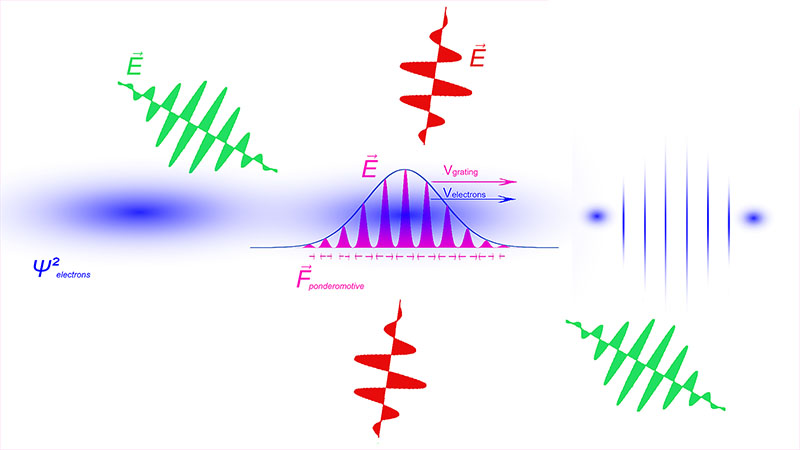| Jun 19, 2023 |
Trillionths of a second: photon pairs compress an electron beam into short pulses
(Nanowerk News) Physicists at the University of Konstanz generate one of the shortest signals ever produced by humans: Using paired laser pulses, they succeeded in compressing a series of electron pulses to a numerically analyzed duration of only 0.000000000000000005 seconds.
|
|
Processes in nature that occur in molecules or solids sometimes run on a time scale of quadrillionths (femtoseconds) or quintillionths (attoseconds) of a second. Nuclear reactions are even faster. Now, Maxim Tsarev, Johannes Thurner and Peter Baum, scientists from the University of Konstanz, are using a new experimental set-up to achieve signals of attosecond duration, i.e. the billionths of a nanosecond, which opens up new perspectives in the field of ultrafast phenomena.
|
|
Not even light waves can achieve such a time resolution, because a single oscillation takes much too long for that. Electrons provide a remedy here, as they enable significantly higher time resolution. In their experimental set-up, the Konstanz researchers use pairs of femtosecond light flashes from a laser to generate their extremely short electron pulses in a free-space beam.
|
|
The results are reported in the journal Nature Physics ("Nonlinear-optical quantum control of free-electron matter waves").
|
 |
| The green and infrared (red) laser pulses, shown as their electric fields superimpose to form a travelling wave crest (pink) that moves at the same velocity (v) with the electrons (shown as a blue cloud). The ponderomotive force (small pink arrows) pushes the electrons in the direction of the next trough valley. Thus a series of electron pulses is generated, which are extremely short in time – especially in the middle of the pulse train, where the electric fields are very strong. (Image: Johannes Thurner)
|
How did the scientists go about it?
|
|
Similar to water waves, light waves can also superimpose to create standing or travelling wave crests and troughs. The physicists chose the incidence angles and frequencies so that the co-propagating electrons, which fly through vacuum at half the speed of light, overlap with optical wave crests and troughs of exactly the same speed.
|
|
What is known as ponderomotive force then pushes the electrons in the direction of the next wave trough. Thus, after a short interaction, a series of electron pulses is generated which are extremely short in time – especially in the middle of the pulse train, where the electric fields are very strong.
|
|
For a short time, the temporal duration of the electron pulses is only about five attoseconds. In order to understand that process, the researchers measure the electrons' velocity distribution that remains after compression.
|
|
"Instead of a very uniform velocity of the output pulses, you see a very broad distribution that results from the strong deceleration or acceleration of some electrons in the course of compression", explains physicist Johannes Thurner. "But not only that: The distribution is not smooth. Instead, it consists of thousands of velocity steps, since only a whole number of light particle pairs can interact with electrons at a time".
|
Significance for research
|
|
Quantum mechanically, the scientist says, this is a temporal superposition (interference) of the electrons with themselves, after experiencing the same acceleration at different times. This effect is relevant for quantum mechanical experiments – for example, on the interaction of electrons and light.
|
|
What is also remarkable: Plane electromagnetic waves like a light beam normally cannot cause permanent velocity changes of electrons in vacuum, because the total energy and the total momentum of the massive electron and a zero rest mass light particle (photon) cannot be conserved. However, having two photons simultaneously in a wave travelling slower than the speed of light solves this problem (Kapitza-Dirac effect).
|
|
For Peter Baum, physics professor and head of the Light and Matter Group at the University of Konstanz, these results are still clearly basic research, but he emphasizes the great potential for future research: "If a material is hit by two of our short pulses at a variable time interval, the first pulse can trigger a change and the second pulse can be used for observation – similar to the flash of a camera."
|
|
In his view, the great advantage is that no material is involved in the experimental principle and everything happens in free space. Lasers of any power could in principle be used in the future for ever stronger compression. "Our new two-photon compression allows us to move into new dimensions of time and perhaps even film nuclear reactions", Baum says.
|

